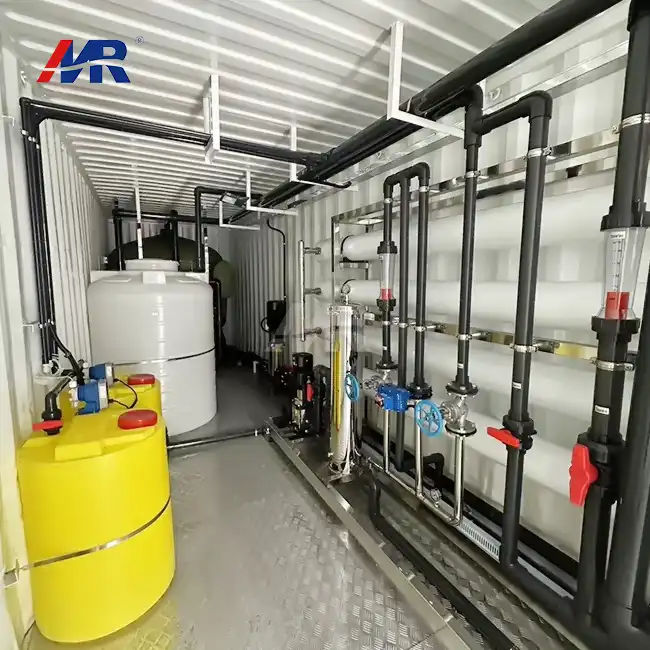RO Membranes in Containerized Systems: What's Unique?
The RO membranes are the cornerstone of any containerized reverse osmosis system. These semi-permeable barriers are designed to remove a vast array of contaminants, including dissolved salts, organic compounds, and microscopic particles. In a containerized RO plant, these membranes are carefully selected and arranged to maximize efficiency within the confined space of a shipping container.
Advanced Membrane Technology for Superior Filtration
Containerized RO systems often employ cutting-edge membrane technology to achieve superior filtration results. These membranes are typically made from composite materials that offer excellent rejection rates for various contaminants while maintaining high water flux. The unique aspect of membranes in containerized systems lies in their compact arrangement and the ability to optimize their performance within a limited footprint.
Some key features of RO membranes in containerized systems include:
- High salt rejection rates (up to 99.8%)
- Low energy consumption
- Resistance to fouling and scaling
- Longevity and durability in harsh environments
The arrangement of these membranes within the containerized unit is crucial. They are often configured in a multi-stage system, allowing for optimal water recovery rates while maintaining high-quality output. This configuration also facilitates easy maintenance and replacement of membrane elements when necessary.
Prefiltration Stages in Container RO Units Explained
Prefiltration is a critical component of any containerized reverse osmosis system, serving as the first line of defense against contaminants that could potentially damage or reduce the efficiency of the RO membranes. In the confined space of a container, these prefiltration stages must be carefully designed to provide maximum protection while occupying minimal space.
Multi-Stage Filtration for Comprehensive Protection
A typical prefiltration system in a containerized RO unit may include several stages:
- Coarse filtration: Removes large particles and debris
- Multimedia filtration: Traps smaller suspended solids
- Activated carbon filtration: Adsorbs organic compounds and chlorine
- Microfiltration or ultrafiltration: Provides a final barrier against fine particles
Each of these stages plays a crucial role in protecting the downstream RO membranes and ensuring the longevity and efficiency of the entire system. The design of these prefiltration stages takes into account the specific challenges of containerized systems, such as limited space and the need for easy maintenance.
One unique aspect of prefiltration in containerized units is the use of compact, high-efficiency filter media that can handle high flow rates while occupying minimal space. Additionally, automated backwash systems are often incorporated to extend the life of the filter media and reduce maintenance requirements.
How Do High-Pressure Pumps Impact RO Performance?
High-pressure pumps are the powerhouse of any reverse osmosis system, and their role is particularly crucial in containerized RO plants. These pumps are responsible for generating the pressure necessary to overcome osmotic pressure and force water through the semi-permeable RO membranes.
Optimizing Pressure for Efficient Separation
In a containerized RO system, high-pressure pumps must be carefully selected to balance performance with space constraints. These pumps typically operate at pressures ranging from 800 to 1200 psi, depending on the feed water quality and desired product water specifications.
Key considerations for high-pressure pumps in containerized RO systems include:
- Energy efficiency: Modern pumps incorporate variable frequency drives to adjust output based on demand
- Noise reduction: Compact, low-noise pump designs are crucial in containerized environments
- Durability: Pumps must withstand continuous operation in various environmental conditions
- Ease of maintenance: Quick-access designs facilitate regular servicing within the confined container space
The impact of high-pressure pumps on RO performance is substantial. Properly sized and maintained pumps ensure consistent pressure across the membrane surface, leading to optimal separation of pure water from contaminants. This results in higher product water quality and improved overall system efficiency.
Moreover, advanced containerized RO systems often incorporate energy recovery devices (ERDs) in conjunction with high-pressure pumps. These devices harness the energy from the concentrated brine stream to assist in pressurizing the feed water, significantly reducing the overall energy consumption of the system.
Conclusion
The key components of a containerized reverse osmosis system work in concert to deliver high-quality water in a compact, efficient package. From the advanced RO membranes to the crucial prefiltration stages and the powerful high-pressure pumps, each element is carefully designed to maximize performance within the constraints of a containerized environment. The container water treatment system, designed for portability and ease of use, ensures that industries and communities can access clean water wherever needed.
As water scarcity and quality issues continue to challenge industries and communities worldwide, containerized RO systems offer a flexible, rapid-deployment solution for a wide range of water treatment needs. The ongoing advancements in membrane technology, filtration systems, and pump efficiency promise even more capable and energy-efficient containerized RO plants in the future.
Are you looking for a reliable, high-performance containerized reverse osmosis system for your industry or community? Look no further than Guangdong Morui Environmental Technology Co., Ltd. Our expert team specializes in designing and manufacturing cutting-edge water treatment solutions tailored to your specific needs. From industrial wastewater treatment to seawater desalination and drinking water production, we offer comprehensive services including equipment supply, installation, commissioning, and after-sales support. With our own membrane production facility and partnerships with leading component manufacturers, we ensure the highest quality and performance in every system we deliver. Don't let water quality issues hold your operations back. Contact us today at benson@guangdongmorui.com to discover how our containerized RO solutions can transform your water treatment processes.
References
1. Johnson, R. A., & Watkins, M. E. (2019). Advances in Containerized Reverse Osmosis Systems for Industrial Applications. Journal of Water Treatment Technology, 42(3), 215-229.
2. Thompson, L. K., & Garcia-Segura, S. (2020). Optimization of Prefiltration Stages in Compact RO Units: A Review. Desalination and Water Treatment, 185, 76-92.
3. Chen, X., & Patel, R. (2021). Energy-Efficient High-Pressure Pumps for Containerized Reverse Osmosis Plants. Environmental Technology & Innovation, 23, 101562.
4. Alvarez-Gaitan, J. P., et al. (2018). Life Cycle Assessment of Containerized RO Systems for Remote Communities. Water Research, 148, 535-547.
5. Kumar, M., & Yadav, D. (2020). Membrane Fouling in Containerized RO Systems: Challenges and Mitigation Strategies. Separation and Purification Technology, 250, 117252.
6. Zhang, Y., et al. (2022). Recent Developments in Energy Recovery Devices for Small-Scale Desalination Units. Renewable and Sustainable Energy Reviews, 156, 111963.

_1745823981883.webp)


